

Panthera. Rohstoff S03E01 - Adam Greenfield and smart cities. Young programmers set a great example. This feel good story came out of San Fran last week. 3 young programmers took it upon themselves to address the glaring omissions of the healthcare.gov website.
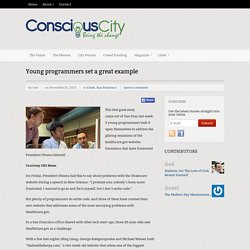
Omissions that have frustrated President Obama himself… Courtesy CBS News On Friday, President Obama had this to say about problems with the Obamcare website during a speech in New Orleans: “I promise you, nobody’s been more frustrated. I wanted to go in and fix it myself, but I don’t write code.” But plenty of programmers do write code. In a San Francisco office shared with other tech start-ups, three 20-year-olds saw HealthCare.gov as a challenge. With a few late nights, Ning Liang, George Kalogeropoulos and Michael Wasser built “thehealthsherpa.com,” a two-week-old website that solves one of the biggest problems with the government’s site.
“They got it completely backwards in terms of what people want up front,” said Liang. Liang showed CBS News how it worked. “There was no thought of, ‘How do we make money this time?’” Source: "The Living Universe," a video by Duane Elgin. City 2.0: The Habitat of the Future and How to Get There (TED Books Book 31) - Kindle edition by TED Books. Arts & Photography Kindle eBooks @ Amazon.com. My thoughts on the smart city - by Rem Koolhaas. Edited transcript of a talk given at the High Level Group meeting on Smart Cities, Brussels, 24 September 2014.
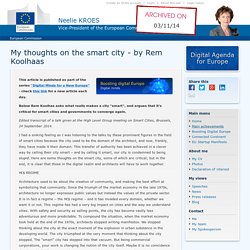
I had a sinking feeling as I was listening to the talks by these prominent figures in the field of smart cities because the city used to be the domain of the architect, and now, frankly, they have made it their domain. This transfer of authority has been achieved in a clever way by calling their city smart – and by calling it smart, our city is condemned to being stupid. The truth about smart cities: ‘In the end, they will destroy democracy'
A woman drives to the outskirts of the city and steps directly on to a train; her electric car then drives itself off to park and recharge.
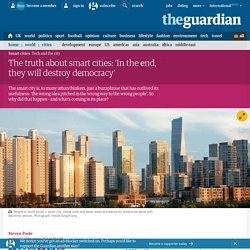
A man has a heart attack in the street; the emergency services send a drone equipped with a defibrillator to arrive crucial minutes before an ambulance can. A family of flying maintenance robots lives atop an apartment block – able to autonomously repair cracks or leaks and clear leaves from the gutters. Such utopian, urban visions help drive the “smart city” rhetoric that has, for the past decade or so, been promulgated most energetically by big technology, engineering and consulting companies. Yet there are dystopian critiques, too, of what this smart city vision might mean for the ordinary citizen. The phrase itself has sparked a rhetorical battle between techno-utopianists and postmodern flâneurs: should the city be an optimised panopticon, or a melting pot of cultures and ideas? And what role will the citizen play? But how safe is open data? 100 Resilient Cities. The smartest cities rely on citizen cunning and unglamorous technology.
We are lucky enough to live at a time in which a furious wave of innovation is breaking across the cities of the global south, spurred on both by the blistering pace of urbanisation, and by the rising popular demand for access to high-quality infrastructure that follows in its wake.

From Porto Alegre’s participatory budgeting and the literally destratifying cable cars of Caracas, to Nairobi’s “digital matatus” and the repurposed bus-ferries of Manila, the communities of the south are responsible for an ever-lengthening parade of social and technical innovations that rival anything the developed world has to offer for ingenuity and practical utility.
Nor is India an exception to this tendency. Cities as Forces for Good Network. Emrals - Rewarding City Cleanup. Social Media Academy - kennis instituut voor social media, communicatie en branding. Moving Toward an Evolutionary Theory of Cities. Before Darwin, science tried to make sense of the natural world through a slew of systems of classification.
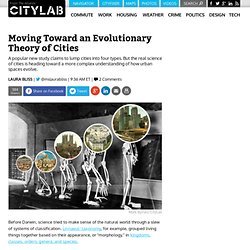
Linnaeus' taxonomy, for example, grouped living things together based on their appearance, or "morphology," in kingdoms, classes, orders, genera, and species. "All taxa show relationships on all sides like the countries on a map of the world," Linnaeus wrote, grasping threads of evolutionary theory—which is to say, that everything on earth descends from a common relative, and that the divergence of life, driven by natural selection, can be traced through physical traits (and later, genetics). But evolutionary theory had to come after Linnaeus, and not to mention, after wobbly ideas of species’ “transmutation” and orthogenesis were debated and discarded. CityLab. Code and the City workshop videos: Session 2. Following up from last week’s videos, we are now into our second session of the Code and the City Workshop!
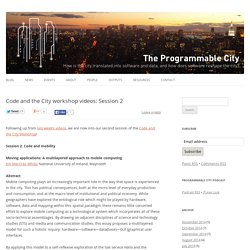
Session 2: Code and mobility Moving applications: A multilayered approach to mobile computing Jim Merricks White, National University of Ireland, Maynooth Abstract Mobile computing plays an increasingly important role in the way that space is experienced in the city. Accelerating the Next Evolution.